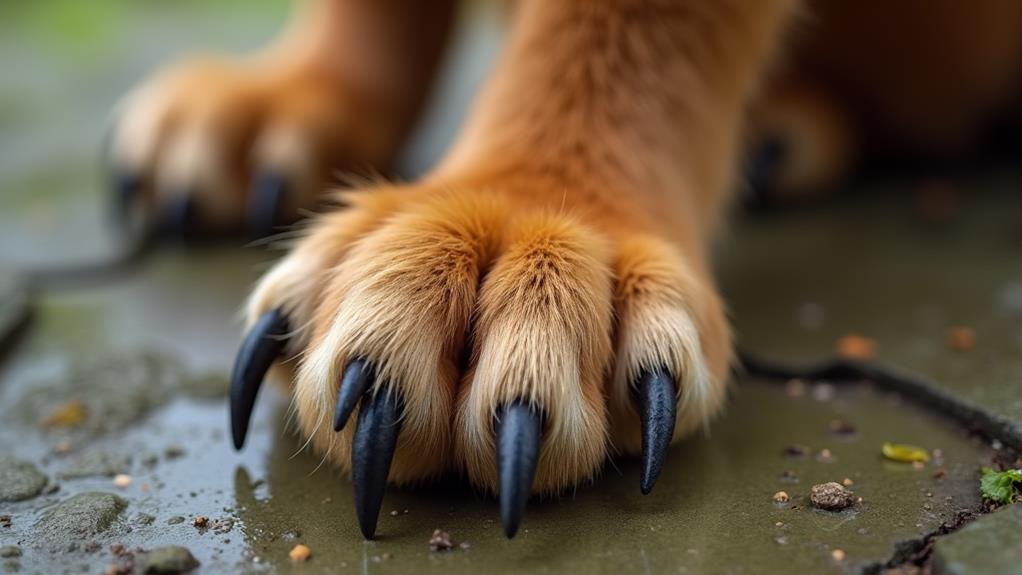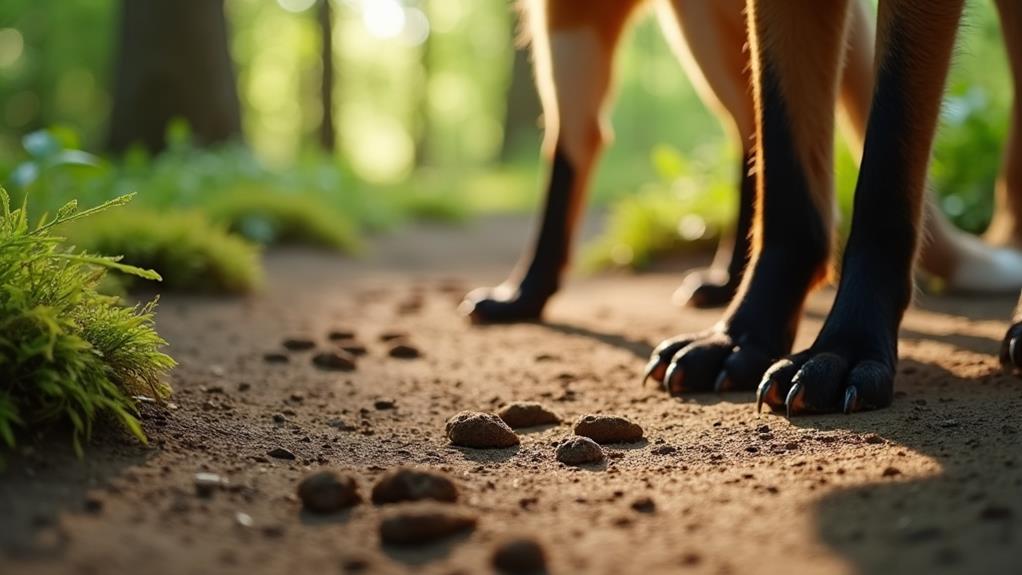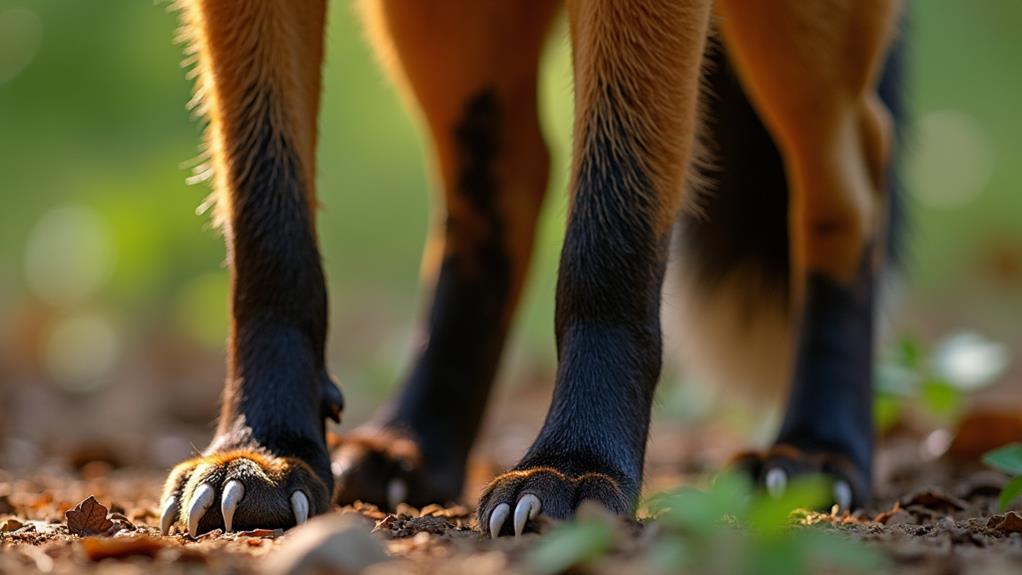Foxes have four toes on their hind legs as a cool adaptation for agility and speed. This unique toe setup helps them grip various terrains, making those quick turns and pounces when they're hunting a piece of cake. Unlike other canids that have five toes, this four-toed design streamlines their movement, letting them zip around without tripping over their own feet. It's kinda like having a built-in sports shoe! So, if you're curious about how this tiny detail fits into the bigger picture of their survival and hunting skills, you're in for a treat.
Contents
Anatomy of Fox Paws

When you examine the anatomy of fox paws, you'll notice some fascinating details that set them apart from other canids. Foxes have four toes on their hind feet, while their forepaws sport five. This unique feature makes them more agile and helps with quick movements, especially when they're darting after prey.
The adaptations of fox species, such as the curious climbing abilities of gray foxes, show how diverse their skills can be. The absence of dewclaws on their hind feet gives those paws a streamlined look, making it easier for them to navigate various terrains.
Each hind foot's toe arrangement not only looks cute but also boosts their ability to pounce precisely and change directions rapidly. So, the next time you spot fox paw prints in the wild, take a closer look. You'll see that they've a distinct diamond shape, which is perfect evidence of their graceful movements.
These paw prints tell a story—each one reveals the cleverness and adaptability of these remarkable creatures. As you explore their anatomy, remember that these unique features enhance their hunting experience and survival skills, showcasing the beauty and efficiency of nature's design.
Isn't it amazing how well-suited they're for their environment?
Function of Four Toes
The agility of foxes can be largely attributed to their unique four-toed hind feet. These toes aren't just for show; they play an essential role in how foxes zip around their environments. With four toes, foxes gain incredible traction and stability, allowing them to run fast and change direction swiftly. Imagine trying to dance on ice with two left feet—it's not easy!
Now, think about a fox chasing after its dinner. The lack of a dew claw on their hind feet helps streamline their paw structure, making every pounce more efficient and effective. When foxes sprint over various terrains, their four toes grip the ground, ensuring they don't slip at just the wrong moment. It's like having built-in snow tires for winter runs!
Plus, their distinctive track patterns tell you a lot about their presence in the wild. The next time you spot those unique prints, you might just appreciate the clever design of those four toes a little more. It's nature's way of crafting supreme agility and survival skills, with a dash of flair! Who knew paws could have such a big impact on life in the wild?
Adaptations for Hunting

When you think about how foxes hunt, their four toes really give them an edge.
These clever creatures can zip around, making sharp turns and quick pounces to catch their favorite snacks—those pesky little mammals that always seem to be one hop ahead.
Their unique foot structure allows for improved agility and grip on various terrains, much like the hunting techniques in the tundra observed in Arctic foxes.
With this anatomical advantage, they not only grip the ground better during a chase, but they also leave behind those cool track patterns that hint at their sneaky stealthy nature.
Hunting Agility Advantages
Throughout their evolutionary journey, foxes have developed remarkable hunting agility advantages that set them apart in the animal kingdom. Their four toes on hind legs play an essential role in boosting their agility while hunting. This adaptation is particularly beneficial in extreme environments like the tundra, where agility can mean the difference between catching prey or going hungry.
Without a dew claw, foxes maintain incredible balance, letting them execute quick pounces and avoid stumbling during a chase. Imagine trying to catch dinner while dancing on a tightrope!
These adaptations grant foxes the grace of a ballet dancer and the speed of a sprinter. Their lightweight skeleton and long hind legs support powerful leaps, helping them swoop in on small mammals with finesse. Plus, the special arrangement of their foot pads creates unique track patterns, giving them traction and control as they move stealthily through varied terrains.
As Arctic foxes navigate their harsh habitats, their physical features are vital for hunting success, especially when competing for resources with larger predators like the red fox.
Whether they're darting around bushes or making sharp turns, these agile hunters represent nature's best at work. So, next time you spot a fox, think of it as a little ninja, artfully blending balance, speed, and agility in its quest for food.
They're not just hunting; they're performing a beautiful act of survival, reminding us that every creature has its special set of skills!
Tracking and Locomotion
Foxes aren't just agile hunters; they also exhibit fascinating adaptations in tracking and locomotion that enhance their hunting prowess. With four toes on their hind legs, foxes enjoy a lighter foot structure that helps them move swiftly and silently. Imagine creeping through a forest, trying not to make a sound—those four-toed paws are like having stealthy little ninja shoes!
The absence of dewclaws on their hind feet boosts their agility, allowing for quick maneuvers while stalking prey. This unique paw structure means they can make precise pouncing movements, essential for catching that sneaky little mouse or a chirping bird. Have you ever tried to balance on one foot? Foxes can maintain grip and stability as they navigate various terrains thanks to their partially retractable claws.
When you spot fox tracks, notice the diamond-shaped patterns left behind—an impressive sign of their specialized locomotion. You can almost picture them gliding through the underbrush, perfectly adapted for a life of keen hunting.
Prey Capture Techniques
Mastering the art of prey capture, foxes combine agility and stealth to outsmart their quarry. With their unique paw structure and four toes on their hind legs, these clever creatures can move swiftly and silently. Imagine the nimbleness needed to sneak up on a plump little rodent! The absence of a dewclaw on those hind feet helps them maintain a streamlined form, making every pounce more efficient.
Foxes are known for their impressive hunting techniques. They often rely on a blend of stealth and quick, explosive sprints fueled by their long hind legs. When they spot their prey, they employ a pouncing technique, leaping into the air to land perfectly on target. Their agile limbs allow them to adjust their trajectory on the way down, showing off their impressive skills.
With a specialized foot pad arrangement that helps them grip various terrains, these animals are clearly built for success.
Comparison With Other Canids
When you think about foxes, their unique paw structure really sets them apart from other canids like domestic dogs and wolves.
While those guys have five toes that help them grip the ground better, foxes sport just four toes on their hind legs, giving them the agility to pounce and dance through the underbrush.
This clever design not only aids in their hunting skills but also emphasizes how evolution shapes different canids for varying lifestyles—who knew toe count could make such a difference?
Unique Paw Structure
In the fascinating world of canids, a notable feature sets foxes apart from their larger relatives like wolves and domestic dogs: their unique paw structure. You might imagine a graceful red fox leaping through the woods with remarkable agility. This is thanks to their clever design — four toes on their hind legs!
Here are three cool things about fox paw structures:
- Forepaws Have Five: Unlike their hind feet, which have just four toes, the forepaws of foxes possess five digits, including a dew claw. This helps them grasp and hold onto prey while hunting!
- Narrow Paw Pads: Foxes have narrower paw pads compared to the broader pads of larger canids. This allows them to create distinctive track patterns that follow the 12-5-3 rule, making tracking them quite a challenge for those who look.
- Absence of Dew Claw: Foxes don't have a dew claw on their hind feet, which distinguishes them from many other canids and showcases their special adaptations.
This unique paw structure truly enhances the red fox's ability to navigate diverse terrains and hunt efficiently. How neat is that?
Adaptations in Hunting
Foxes, with their agile bodies and specialized hunting techniques, present a fascinating contrast to other canids like wolves and coyotes. While wolves chase down prey in a pack, using their robust structures for endurance, foxes take a different approach. Their four toes on hind legs let them pounce swiftly and quietly, making them stealthy hunters of small mammals.
You might notice that foxes don't have dew claws on their hind feet. This unique trait helps them navigate tricky terrains with efficiency, ensuring they can spring into action without any hindrance. Their light skeleton and long legs allow for precise movements, setting them apart from the bulkier canids.
What's interesting is that the fur covering their paws plays a role too! It offers insulation and aids in silent steps, like nature's own stealthy shoes. This combination of factors makes hunting an art form for them.
Foxes often adapt on the fly based on prey availability, meaning they can change their hunting strategy quicker than you can say "where's my dinner?" So, next time you see a fox, remember they're more than just cute creatures; they're skilled hunters in their own right!
Comparison With Domestic Dogs
The agility and hunting prowess of foxes stand in stark contrast to domestic dogs. While both belong to the canine family, their paw adaptations reveal fascinating differences influenced by toes evolution. Foxes have only four toes on their hind legs, which offers better stability and maneuverability in their natural habitats. In comparison, domestic dogs typically have five toes on both front and hind paws.
Here's why these features are so interesting:
- Streamlined structure: Foxes lack a dew claw on their hind feet, aiding in their stealthy movement.
- Distinctive prints: The triangular paw pads and ovular toes of foxes create unique paw prints, unlike the rounded prints we're used to seeing from dogs.
- Purposeful gait: The specific hind paw configuration of foxes is essential for their hunting style, setting them apart in the domain of canine diversity.
These adaptations allow foxes to dart swiftly through their environment, making them extraordinary hunters.
Impact on Mobility

For many animals, the design of their feet plays a crucial role in how they move across diverse landscapes, and foxes are no exception. Their four toes offer some serious evolutionary advantages. These clever adaptations enhance agility and speed, so you can picture a fox swiftly darting through the forest or pouncing on unsuspecting prey.
The unique structure of their hind feet, featuring a lighter skeleton and longer legs, helps them navigate various terrains, whether it's rocky ground or a soft meadow. With the absence of a dewclaw on the hind feet, foxes enjoy a streamlined foot design that reduces drag while running. This means they can accelerate quickly to escape danger or catch lunch!
Furthermore, the specific arrangement of their foot pads creates a unique track pattern, improving footpad sensitivity. This aids their stealthy approach when stalking prey, making them more effective hunters.
Balancing and stabilizing on uneven ground becomes much easier with their clever toe configuration, ensuring they remain nimble on their feet. Overall, foxes' foot design is a fascinating example of how evolution shapes mobility in the wild, making these adorable creatures even more impressive!
Ecological Significance
In ecosystems where predators and prey constantly interact, the ecological significance of a fox's unique toe structure becomes evident. You might wonder how a simple adaptation can ripple through the ecosystem. Well, these clever creatures play an essential role in maintaining ecosystem balance and predator dynamics.
Here's how their four-toed marvel helps:
- Enhanced Agility: The four toes let foxes dash and weave through various terrains, which is important when they're hunting or dodging predators.
- Weight Distribution: This unique design helps them distribute their weight evenly, keeping them steady and agile as they pounce.
- Population Control: By efficiently catching small mammals, foxes help control their populations, preventing overpopulation that could disrupt the ecosystem.
With their speed and balance, foxes become effective hunters, playing a key part in population control. This not only keeps the prey in check but also maintains a healthier ecosystem.
Myths and Misunderstandings

Many people hold misconceptions about foxes and their unique toe structure, often overlooking how these traits enhance their agility and hunting prowess.
One common myth is that foxes have five toes on their hind legs like some other canids. However, they actually sport only four toes, which makes them swift hunters. This isn't a sign of being less evolved; it's their evolutionary perspective at work!
Another frequent misunderstanding is about the dew claw. Many think it works like a cat's retractable claw, but its main job is to boost stability while running around, not to ambush prey.
You might also hear that all canids should have the same paw design, but that's just another misconception! Each species has adapted its toe structure to suit its particular environment.
Lastly, fox footprints can be identified using the 12-5-3 rule, a cool little detail that showcases their nimble footwork.
Conservation Status of Foxes
What challenges do foxes face in today's rapidly changing world? While many fox species enjoy stable populations, they're not completely in the clear. Urbanization and agricultural expansion are encroaching on their habitats, making it tough for these clever creatures to find food and shelter.
Here are three key concerns:
- Habitat Loss: As cities grow and farmland expands, foxes lose their natural living spaces, impacting their population dynamics.
- Climate Change: Some species, like the Arctic fox, are facing dire consequences due to changing climates, which can lead to vulnerabilities and even endangerment.
- Health Issues: Outbreaks of diseases like rabies pose a significant threat to local foxes, highlighting the need for wildlife health management.
These concerns remind us of the importance of habitat preservation and species diversity.
Conservation efforts aim to protect habitats and promote awareness about the needs of foxes. By valuing these adorable creatures and their environment, you help guarantee they thrive in their natural homes.
Observational Studies and Tracking

Observational studies and tracking reveal fascinating insights into fox behavior and movement patterns. When you engage in tracking, you'll notice that foxes' unique four-toed hind legs enhance their agility. This helps them skitter away from predators and stealthily hunt for dinner! You can identify fox prints in the snow, where their hind paw tracks are about 1¼ inches smaller than their front paws, showcasing their distinct locomotion.
These tracking adventures not only reveal behavioral patterns but also how environmental influences shape seasonal adaptations. For instance, foxes adapt to changing seasons by altering their hunting methods and travel routes—nature's way of keeping them on their toes, pun intended!
If you ever stumble upon fox tracks, keep an eye out for their diamond-shaped hind prints and the chevron-shaped callus ridge that sets red foxes apart. It's like their signature on the canvas of the wilderness.
These studies not only deepen our understanding of our wild neighbors but also remind us of the importance of respecting and serving the natural world around us! So, the next time you're outside, look down—who knows what fox tales the ground will tell?
Final Thoughts
So, there's a lot more to those four toes than you might think! While some folks might wonder if having fewer toes means they're less agile, it's quite the opposite. Those four toes give foxes a fantastic grip and agility, perfect for sneaking up on dinner. Plus, their unique foot structure helps them adapt to various environments. Next time you spot a fox, you'll appreciate its clever design a bit more—like nature's little engineers strutting their stuff!














